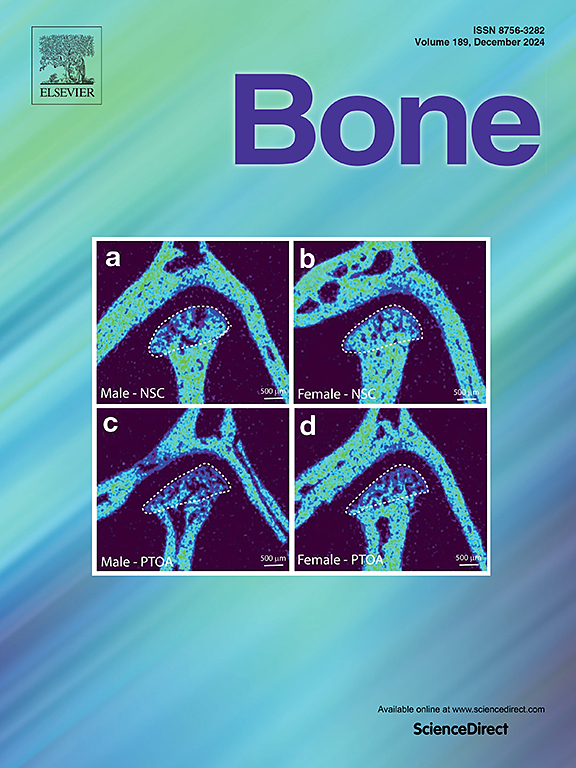Bone properties in persons with type 1 diabetes and healthy controls – A cross-sectional study
IF 3.5
2区 医学
Q2 ENDOCRINOLOGY & METABOLISM
引用次数: 0
Abstract
Background
The risk of fractures is increased in persons with type 1 diabetes (T1D) and assessment of bone health has been included in the 2024 updated Standards of Care by The American Diabetes Association (ADA). Previous studies have found that in T1D bone metabolism, mineral content, microstructure, and strength diverge from that of persons without diabetes. However, a clear description of a T1D bone phenotype has not yet been established. We investigated bone mechanical properties and microstructure in T1D compared with healthy controls. For the potential future introduction of additional bone measures in the clinical fracture risk assessment, we aimed to assess any potential associations between various measures related to bone indices in subjects with T1D.
Methods
We studied human bone indices in a clinical cross-sectional setup including 111 persons with early-onset T1D and 37 sex- and age-matched control persons. Participants underwent hip and spine DXA scans for bone mineral density (BMD) of the femoral neck (FN), total hip (TH), and lumbar spine (LS), and TBS evaluation, microindentation of the tibial shaft for Bone Material Strength index (BMSi), and high-resolution periphery quantitative computed tomography (HRpQCT) of the distal radius and tibia for volumetric BMD (vBMD) and structural measures of trabecular and cortical bone. Results are reported as means with (standard deviation) or (95% confidence intervals (CI)), medians with [interquartile range], and differences are reported with (95% CI).
Results
The study included 148 persons aged 20 to 75 years with a median age of 43.2 years. The T1D group who had all been diagnosed with T1D before the age of 18 years demonstrated values of HbA1c ranging from 39 to 107 mmol/mol and a median HbA1c of 57 mmol/mol. The BMD did not differ between groups (the mean difference in FN-BMD was 0.026 g/cm2 (−0.026; 0.079), p = 0.319) and the median BMSi was comparable in the two groups (79.2 [73.6; 83.8] in the T1D group compared with 77.9 [70.5, 86.1] in the control group). Total and trabecular vBMD (Tb.vBMD), cortical thickness (Ct.Th), and trabecular thickness (Tb.Th) of both radius and tibia were lower in participants with T1D. The mean Tb.vBMD at the radius was 143.6 (38.5) mg/cm3 in the T1D group and 171.5 (37.7) mg/cm3 in the control group, p < 0.001. The mean Ct. Thd of the radius was 0.739 mm (0.172) in the T1D group and 0.813 (0.188) in the control group, p = 0.044. Crude linear regressions revealed limited agreement between BMSi and Tb.vBMD (p = 0.010, r2 = 0.040 at the radius and p = 0.008, r2 = 0.040 at the tibia and between BMSi and the estimated failure load (FL) at the tibia (p < 0.001, r2 = 0.090). There were no significant correlations between BMSi and Ct.Th. TBS correlated with Tb.vBMD at the radius (p = 0.008, r2 = 0.044) and the tibia (p = 0.001, r2 = 0.069), and with the estimated FL at the distal tibia (p = 0.038, r2 = 0.026).
Conclusion
In this study, we examined the bones of persons with well-controlled, early-onset T1D. Compared with sex- and age-matched healthy control persons, we found reduced total and trabecular vBMD, as well as decreased trabecular and cortical thickness. These results suggest that a debut of T1D before reaching peak bone mass negatively impacts bone microarchitecture. No differences in areal BMD or BMSi were observed. Although the variations in total hip BMD reflect some variation in the vBMD, the reduction in trabecular bone mineral density was not captured by the DXA scan. Consequently, fracture risk may be underestimated when relying on DXA, and further research into fracture risk assessment in T1D is warranted.
1 型糖尿病患者和健康对照组的骨骼特性 - 一项横断面研究
背景1型糖尿病(T1D)患者发生骨折的风险增加,美国糖尿病协会(ADA)已将骨骼健康评估纳入2024年更新的护理标准。以往的研究发现,T1D 患者的骨代谢、矿物质含量、微观结构和强度与非糖尿病患者存在差异。然而,关于 T1D 骨表型的明确描述尚未确立。我们研究了 T1D 与健康对照组相比的骨机械性能和微观结构。为了将来在临床骨折风险评估中引入更多的骨骼测量指标,我们旨在评估与 T1D 患者骨骼指数相关的各种测量指标之间的潜在关联。方法我们在临床横断面设置中研究了人体骨骼指数,包括 111 名早发 T1D 患者和 37 名性别和年龄匹配的对照组患者。参与者接受了股骨颈(FN)、全髋(TH)和腰椎(LS)骨质密度(BMD)的髋关节和脊柱 DXA 扫描以及 TBS 评估、骨材料强度指数(BMSi)的胫骨轴显微压痕检查,以及桡骨远端和胫骨的高分辨率外围定量计算机断层扫描(HRpQCT),以测量骨体积密度(vBMD)以及骨小梁和皮质骨的结构。结果以带有(标准差)或(95% 置信区间 (CI))的均值、带有[四分位间范围]的中位数以及带有(95% CI)的差异进行报告。T1D 组患者均在 18 岁前被诊断出患有 T1D,他们的 HbA1c 值从 39 mmol/mol 到 107 mmol/mol 不等,中位 HbA1c 值为 57 mmol/mol。两组的 BMD 没有差异(FN-BMD 的平均差异为 0.026 g/cm2 (-0.026; 0.079),p = 0.319),两组的 BMSi 中位数相当(T1D 组为 79.2 [73.6; 83.8],对照组为 77.9 [70.5, 86.1])。T1D患者桡骨和胫骨的总vBMD和小梁vBMD(Tb.vBMD)、皮质厚度(Ct.Th)和小梁厚度(Tb.Th)均较低。T1D 组桡骨的平均 Tb.vBMD 为 143.6 (38.5) mg/cm3,对照组为 171.5 (37.7) mg/cm3,P < 0.001。桡骨的平均Ct.T1D组桡骨的平均Ct.Thd为0.739毫米(0.172),对照组为0.813(0.188),P = 0.044。粗线性回归显示,BMSi 和 Tb.vBMD 之间的一致性有限(桡骨为 p = 0.010,r2 = 0.040;胫骨为 p = 0.008,r2 = 0.040),BMSi 和胫骨的估计破坏负荷 (FL) 之间的一致性也有限(p < 0.001,r2 = 0.090)。BMSi 与 Ct.Th 之间无明显相关性。TBS与桡骨(p = 0.008,r2 = 0.044)和胫骨(p = 0.001,r2 = 0.069)的Tb.vBMD相关,与胫骨远端的估计FL相关(p = 0.038,r2 = 0.026)。与性别和年龄相匹配的健康对照组相比,我们发现总骨量和骨小梁vBMD降低,骨小梁和皮质厚度减少。这些结果表明,在达到峰值骨量之前首次发病的 T1D 会对骨微结构产生负面影响。在全髋骨密度(areal BMD)或全髋骨密度(BMSi)方面没有观察到差异。虽然总髋部 BMD 的变化反映了 vBMD 的一些变化,但 DXA 扫描并未捕捉到骨小梁骨矿物质密度的降低。因此,依靠 DXA 可能会低估骨折风险,因此有必要对 T1D 骨折风险评估进行进一步研究。
本文章由计算机程序翻译,如有差异,请以英文原文为准。
求助全文
约1分钟内获得全文
求助全文
来源期刊

Bone
医学-内分泌学与代谢
CiteScore
8.90
自引率
4.90%
发文量
264
审稿时长
30 days
期刊介绍:
BONE is an interdisciplinary forum for the rapid publication of original articles and reviews on basic, translational, and clinical aspects of bone and mineral metabolism. The Journal also encourages submissions related to interactions of bone with other organ systems, including cartilage, endocrine, muscle, fat, neural, vascular, gastrointestinal, hematopoietic, and immune systems. Particular attention is placed on the application of experimental studies to clinical practice.
 求助内容:
求助内容: 应助结果提醒方式:
应助结果提醒方式:


